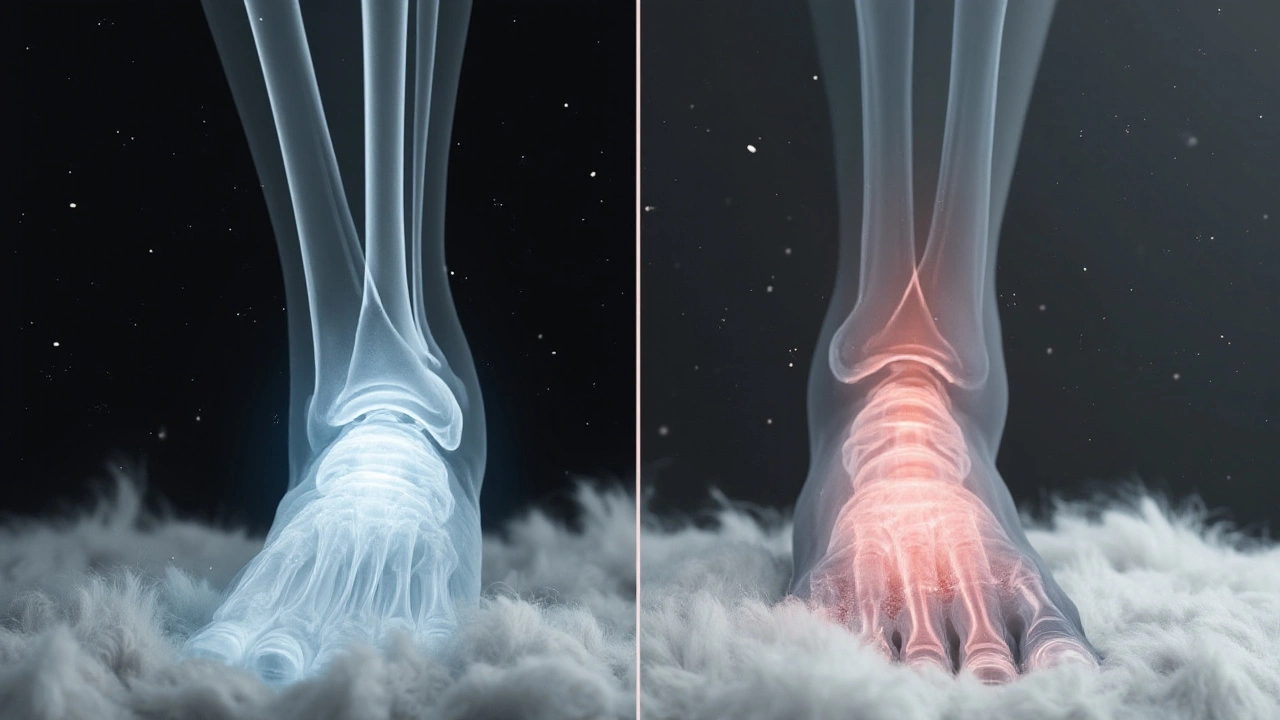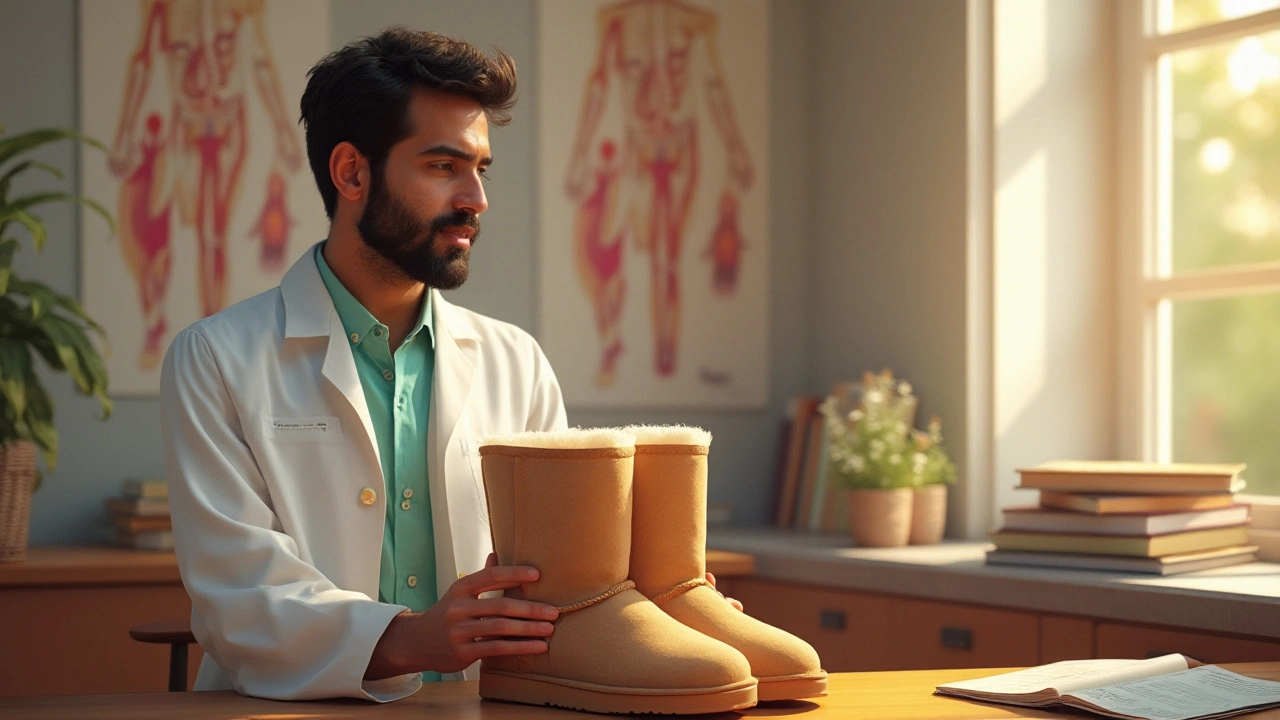Uggs, those warm and cozy boots we all know and love, have become more than just a winter fashion must-have. As comfortable as they are, have you ever wondered how foot-friendly they really are? With so many choices for snug foot coverings, it’s important to know if Uggs are the right fit for your feet—literally and figuratively.
Podiatrists, the foot experts among us, have quite a bit to say about what keeps our feet healthy. But when it comes to Uggs, their opinions are as varied as the styles of the boots themselves. In this article, we'll dive into some expert opinions and uncover the truth about Uggs and foot health. If you've been curious about how your favorite winter boots stack up in the realm of foot support, you’re in for an informative ride.
- Understanding Uggs and Their Popularity
- Do Podiatrists Approve? Expert Opinions
- The Anatomy of Uggs: Pros and Cons
- Tips for Choosing Foot-Friendly Slippers
- Alternative Footwear for Comfort and Support
Understanding Uggs and Their Popularity
Ugg boots, those iconic sheepskin-lined shoes that have warmed countless toes, have quite the storied history. Originally invented in the 1970s by Australian surfers, Uggs were initially crafted to provide easy-to-slip-on comfort after long surf sessions. The blend of sheepskin and fleece made for a uniquely cozy experience, perfect for tired feet needing a quick warm-up. Fast forward to today, and Uggs have transcended their origins, evolving into a global phenomenon embraced by everyone from celebrities strutting airport runways to college students braving cold campus mornings.
Their meteoric rise in the early 2000s can be attributed to a clever mix of celebrity endorsements and strategic marketing. Uggs seemed to appear everywhere from glamorous photoshoots to reality TV, quickly securing their place as a wardrobe staple. Interestingly, their appeal wasn't just about the look; it was about the feeling too. There’s something inherently inviting about slipping into a fluffy, soft boot on a chilly day, making them a natural choice in countries that experience harsh winters. A 2013 report by the retail analytics firm NPD Group even noted a significant increase in slipper sales, attributing Uggs as a key component of this shift.
Despite their fashion-forward presence in modern wardrobes, debates about their practicality and health implications continue. Some podiatrists warn about the flat sole design, suggesting that while Uggs offer warmth, they might not provide the necessary support for prolonged use. Dr. Megan Leahy, a well-respected podiatrist in Chicago, once said,
"While Uggs are incredibly comfortable, they are not designed for walking long distances. Their lack of arch support can lead to aches and issues when worn for prolonged periods."This balance between comfort and potential foot health concerns is part of what makes conversations about Uggs so intriguing.
Moreover, in recent years, Uggs have tried to adapt to consumer needs with innovative designs that include more structured soles and a variety of styles, including waterproof versions, all aimed at extending their usability beyond plush living room floors. While these updates might address some concerns, it’s essential to note that original models still dominate the market in terms of popularity. Whether you view them as practical staple or fashion statement, Uggs continue to hold a special place in contemporary shoe culture. An interesting look at sales volume over a decade, if one were available, could likely show an impressive number in the millions that reflect their ongoing demand and presence globally.
Do Podiatrists Approve? Expert Opinions
When it comes to choosing footwear, particularly something as universally adored as Uggs, many wonder if these stylish boots are giving their feet the support they need. According to many podiatrists, the answer is often more nuanced than a simple yes or no. Podiatrists, who specialize in foot health, emphasize the importance of proper arch support, sufficient cushioning, and an overall fit that encourages natural foot motion. Uggs, known for their luxurious shearling lining and soft suede exterior, provide an unparalleled comfort but often lack the structural support found in orthopedic-friendly shoes. People who wear these boots may notice they feel like slipping into a pair of cozy socks rather than sturdy footwear. This coziness, while appealing, might not provide the best foundation for walking throughout the day.
The lack of arch support in standard Uggs is one of the key concerns raised by foot experts. Podiatrists often highlight the risk of developing foot problems such as plantar fasciitis, a condition that arises from strained ligaments in the arch of the foot. Without proper support, the foot's structure can alter, leading to discomfort and pain over time. According to Dr. John Whyte, a known expert in the field of foot and ankle health, "Footwear must do more than just feel comfortable; it must support your body's biomechanics." He points out that while Uggs are fine for occasional wear or lounging at home, consumers should be cautious about over-relying on them for everyday activities, especially long walks.
In addition to structural concerns, podiatrists are wary about the flat nature of the Uggs' sole. The absence of cushioning in the heel can lead to a higher impact on the foot with each step, potentially leading to joint strain over time. Experts often suggest inserting orthotic insoles to add a layer of support if Uggs are to be worn regularly. This is particularly crucial for those who have flat feet or overpronate, as their foot mechanics require additional alignment and support. In a world where fashion frequently conflicts with function, podiatrists underscore the importance of balance: finding a shoe that marries comfort with health support. Foot health should be a priority aside from fashion preferences.
Interestingly, there has been an increasing trend among manufacturers to produce Ugg-style boots that integrate more supportive features. Enhanced arch support, improved heel cushioning, and customizable insoles are slowly making their way into the market. Podiatrists applaud these developments and encourage consumers to consider these upgraded versions if they love the iconic Ugg look but desire more foot health benefits. However, it's essential that consumers do their research, as not all options are created equally, and professional recommendations can help chart the right course.
To conclude, while Uggs offer undeniable comfort and warmth, they might not be suitable for everyone to wear all the time. For those who love their Uggs but are concerned about maintaining good foot health, consulting with a podiatrist can provide personalized advice. Many podiatrists recommend wearing Uggs in moderation and opting for more supportive footwear for extensive walking or prolonged wear. After all, happy feet lead to a happy stroll.

The Anatomy of Uggs: Pros and Cons
When it comes to comfort and style, Uggs have made a name for themselves as a go-to choice for many seeking warmth and luxury at their feet. These boots, made primarily from sheepskin, are soft and inviting, almost like wearing a hug. However, there’s more to these popular boots than meets the eye. Let’s break down what makes Uggs both beloved and, at times, debated in terms of foot health.
One of the biggest draws of Uggs is their cozy interior, lined with plush wool that provides excellent insulation. This means your feet stay toasty warm, a significant perk for those chilly winter days. What's more, Uggs are incredibly easy to slip on and off, making them a convenient option for those always on the go. The exterior, often crafted from supple suede, adds a touch of casual elegance that suits a range of outfits, from leggings to jeans.
However, the design of Uggs isn’t without its drawbacks. One significant concern raised by some podiatrists is the boot’s lack of arch support. Unlike specialized orthopedic shoes, Uggs offer a flat sole, which can be a challenge for individuals with conditions like plantar fasciitis or flat feet. This absence of a structured footbed can lead to inadequate support, causing discomfort during prolonged use.
Another topic of discussion is the potential for the interior to compress over time. As the wool lining gradually flattens with wear, the fit can change, leading to less cushioning and support. This shift might result in your feet sliding around inside the boot, potentially causing friction and blisters. Despite their warm embrace, it's important to consider how prolonged wear could impact foot health over an extended period.
Foot Expert Opinions
Podiatrists have expressed mixed views about the impact of regularly wearing Uggs. While acknowledging the undeniable comfort, many recommend moderation. As Dr. Emily Splichal, a respected expert in functional podiatry, once noted:
"Soft slippers like Uggs offer incredible comfort short-term, but wearing them every day without alternating with more supportive options can lead to long-term issues."This suggests a balanced approach, incorporating other footwear options for consistent support.
Lastly, it’s worth noting the environmental and ethical considerations tied to the production of sheepskin boots. Some consumers may seek eco-friendlier alternatives, mindful of sustainable fashion trends. However, for those who can’t resist the allure of these iconic boots, pairing them with orthotic inserts might strike the right balance between comfort and care. After all, foot health should never be a sacrifice, even in the name of style.
Tips for Choosing Foot-Friendly Slippers
Finding the right pair of slippers can transform your comfort at home, especially if you’re someone who spends a lot of time walking on hard surfaces. When it comes to choosing your perfect companions for relaxation at home, there are a few key elements to consider. Firstly, the support is crucial. Just like any other footwear, slippers should provide adequate arch support to prevent discomfort and long-term issues. Breathability is also vital, especially if you wear them for extended periods. Look for materials like wool or cotton that allow your feet to breathe and help maintain a comfortable temperature, avoiding excessive sweating.
A good fit is equally important. Ill-fitting slippers can cause blisters or stress on your feet. Make sure your slippers have enough room for wiggling toes but not so loose that they slip off while walking. As much as you enjoy the coziness of fluffy linings, ensure they don't compromise on fit. Many podiatrists emphasize the importance of sturdy soles as well. While soft soles feel delightful, a thicker and slightly firmer sole can absorb shock better and offer more stability on tiled or wooden floors.
Consider the design and ease of use. Slippers that require bending over or intricate lacing might not be ideal for everyone, especially those with mobility concerns. Slip-on styles are convenient and often preferred by many. In terms of material, leather slippers offer durability and often age well, forming to the shape of your feet. But they come with a higher price tag. Meanwhile, synthetic options might be lighter on the wallet but don’t always guarantee longevity. A study revealed that slippers are one of the most returned items online, often due to sizing issues.
"Your feet are the foundation of your body, and choosing the right slippers can play a significant role in alleviating stress on your entire skeletal system," says Dr. Elizabeth V. Johnson, a renowned podiatrist.
For those with specific foot conditions, such as plantar fasciitis, investing in orthopedic slippers might be a wise choice. These are designed with special insoles, catering specifically to common foot ailments. Keep an eye out for reviews and recommendations from trusted sources if you're uncertain about which brand to trust. Podiatrists often suggest trying on slippers in-store, if possible, to get a real feel for their comfort since online measurements can sometimes be misleading.
Finally, while style might attract you initially, remember that the primary purpose of slippers is to support and cushion your feet. Hopefully, with the right choice, your slippers can become more than just a home accessory—they’ll become a vital part of your daily comfort routine.

Alternative Footwear for Comfort and Support
When it comes to ensuring foot health, choosing the right type of footwear is paramount. For those who crave the warm embrace of Uggs but wish for arch support or cushioning that meets podiatric approval, there are numerous alternatives available. These options blend comfort with essential support features valued by foot health specialists. The choices range from environmentally friendly materials to innovative designs that cater to natural foot movement. Among popular options are shearling-lined boots that provide similar coziness while offering better structural integrity.
For indoors, slippers with memory foam cushioning are becoming a go-to choice. They mold to the shape of your foot, providing a personalized touch that many appreciate for daily home wear. Brands like Vionic have engineered slippers that boast arch support alongside plush comfort, making them a worthy choice for those with plantar fasciitis or other foot ailments. It's worth noting that the American Podiatric Medical Association has endorsed several slippers for their foot health benefits, which is reassuring for those looking out for certified recommendations.
"Footwear should never be an afterthought," says Dr. Maria Edwards, a leading podiatrist. "Your feet are the foundation of your body, and properly supporting them enhances overall health."
Sports enthusiasts may seek sneakers from companies that integrate technology aimed at enhancing foot posture and gait. Many athletic brands today utilize state-of-the-art materials that not only advance performance but also augment comfort for casual daily wear. By ensuring your sneakers have adequate padding and stability control, one can prevent common issues like heel pain or misalignment. Recent studies show that nearly 70% of people experience foot pain at some point, often linked to inadequate footwear—a clear call for mindful shoe selection.
The Role of Materials
The material of your footwear plays a significant role in its comfort and support level. Natural materials, such as leather and cotton, allow your feet to breathe, which is essential for long-term wear. Conversely, synthetic materials might offer durability but could trap heat, leading to discomfort. Some innovative brands have integrated sustainable and breathable materials into their designs, offering the best of both worlds. For instance, wool-based sneakers provide temperature regulation and moisture-wicking properties, which maintain comfort across various climates and pair splendidly with a casual, laid-back style.
| Brand | Feature | Podiatrist Endorsement |
|---|---|---|
| Vionic | Arch Support | Yes |
| Allbirds | Eco-Friendly Materials | No |
| Birkenstock | Contoured Footbed | Yes |
